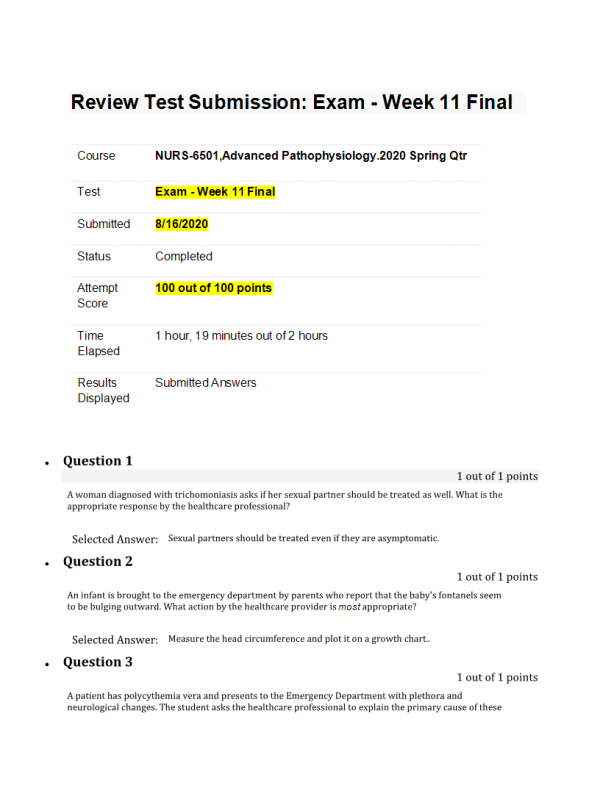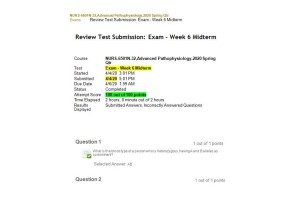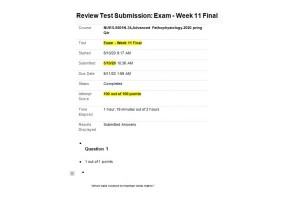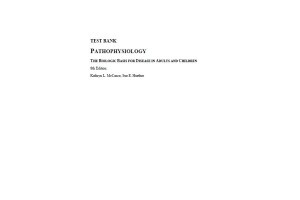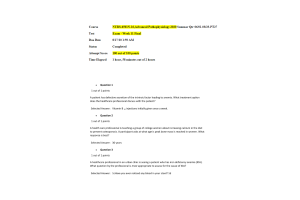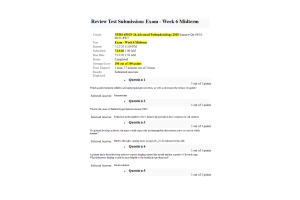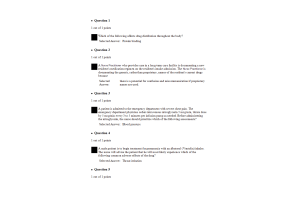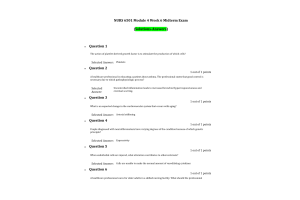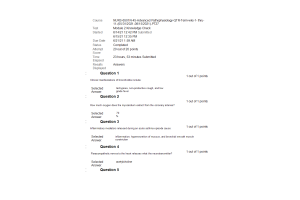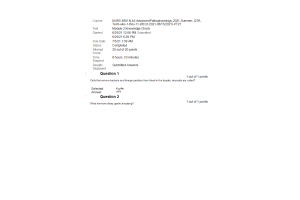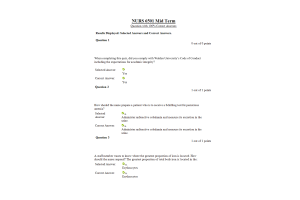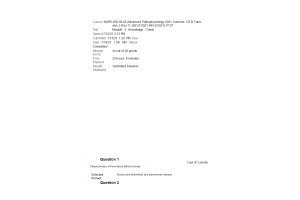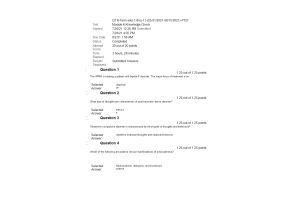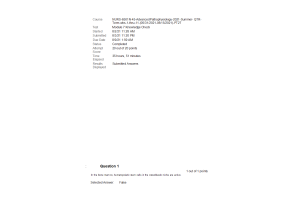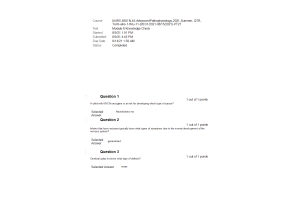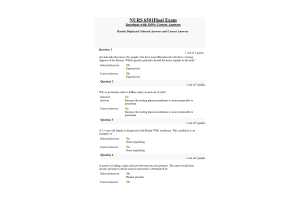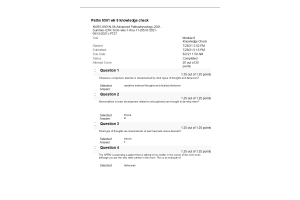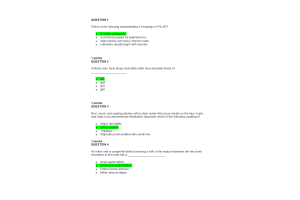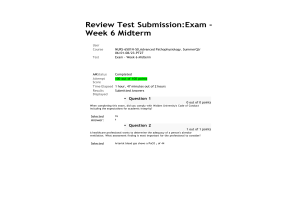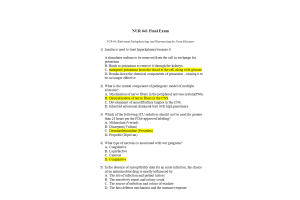NURS 6501 Week 11 Final Exam100 out of 100 Points
- $49.00
- Question: A woman diagnosed with trichomoniasis asks if her sexual partner should be treated as well. What is the appropriate response by the healthcare professional?
- Question: An infant is brought to the emergency department by parents who report that the baby's fontanels seem to be bulging outward. What action by the healthcare provider is most appropriate?
- Question: A patient has polycythemia vera and presents to the Emergency Department with plethora and neurological changes. The student asks the healthcare professional to explain the primary cause of these symptoms. What response by the professional is best?
- Question: When are childhood cancers most often diagnosed?
- Question: A severely malnourished patient is in the hospital to improve nutrition. On the second day, the patient reports palpitations and difficulty breathing. After placing the patient on a cardiac monitor, what action does the health care professional take next?
- Question : The student wants to know how the clinical manifestations and onset of juvenile idiopathic arthritis (JIA) differ from those of rheumatoid arthritis (RA) in adults. What answer by the healthcare professional is best?
- Question: A patient has a temporary displacement of two bones in a joint causing the bone surfaces to partially lose contact with each other. What treatment does the health care professional prepare the patient for?
- Question: A preschool teacher notices a child who has burrows on the hands that are several millimeters to 1 cm long, papules, and vesicular lesions. What other assessment finding would help the teacher determine the type of infestation the child has?
- Question: The disruption in cellular adhesion observed in bullous impetigo is caused by an exfoliative toxin related to which organism?
- Question: A mother reports that her young teens have voracious appetites. The healthcare professional would explain that which hormone is linked to an increase in appetite during puberty?
- Question: What diagnosis is given to parents when their infant's hip maintains contact with the acetabulum but is not well seated within the hip joint?
- Question :The healthcare professional directs a student to assess a teen who has Osgood-Schlatter disease. What assessment finding does the student anticipate for this disorder?
- Question: What are the clinical manifestations of testicular cancer?
- Question: A man reports to the healthcare professional that he had a sudden onset of malaise, low back pain, and perineal pain with high fever and chills, dysuria, nocturia, and urinary retention. What action by the healthcare professional is most appropriate?
- Question: An infant has been diagnosed with intussusception and the student asks the healthcare professional to explain the condition. What explanation by the professional is most accurate?
- Question: Which statement by the healthcare professional accurately describes childhood asthma?
- Question: A patient is in status epilepticus. In addition to giving medication to stop the seizures, what would the healthcare professional place highest priority on?
- Question: A health care professional determines that the student needs more education when the student makes which statement about treating bone infection?
- Question: A health care professional is teaching a group of college women about increasing calcium in the diet to prevent osteoporosis. A participant asks at what age is peak bone mass is reached in women. What response is best?
- Question: What is the link between major depression and cortisol secretion?
- Question: A student asks the professor to explain the jaundice that accompanies hemolytic anemia. Which statement is by the professor is most accurate?
- Question: Which cells function to maintain bone matrix?
- Question: A child has Duchenne muscular dystrophy and the parents want to know how this occurred. Which statement by the healthcare professional is most accurate?
- Question: What is the role of thromboxane A (TXA 2) in the secretion stage of hemostasis?
- Question: A healthcare professional is educating a community men's group on symptoms of benign prostatic hyperplasia (BPH). The professional relates that most symptoms are a result of which pathophysiologic condition?
- Question: A student studying osteomyelitis and asks for an explanation of the term sequestrum. What response by the professor is best?
- Question: A child with acute poststreptococcal glomerulonephritis is voiding smoky, brown-colored urine and asks the healthcare professional to explain what causes it. What explanation by the professional is best?
- Question: A patient has been diagnosed with lithium toxicity. Which electrolyte imbalance does the healthcare professional correlate with this condition?
- Question: A 7 year-old-child presents to the clinic where parents report signs and symptoms consistent with asthma. What does the healthcare professional do in order to confirm this diagnosis?
- Question: A 9-year-old child has a blood pressure of 112/72 mmHg in the school nurse's office. What action by the school nurse is most appropriate?
- Question: A patient has primary immune thrombocytopenic purpura (ITP) and is hospitalized after a bleeding episode. What treatment does the healthcare provider anticipate being ordered for this patient?
- Question: What is the consequence of a splenectomy?
- Question: Gait disturbances and instability are characteristic of which form of cerebral palsy?
- Question: A person has been diagnosed with acute lymphocytic leukemia (ALL) that is positive for the Philadelphia chromosome. What statement by the healthcare professional is most appropriate?
- Question: A patient in the clinic had a femur x-ray that was read as having a moth-eaten appearance. What treatment option does the health care professional discuss with the patient?
- Question: Local signs and symptoms of Hodgkin disease-related lymphadenopathy are a result of what?
- Question: A child has scoliosis with a 40-degree curvature of the spine, and the parent is worried about pulmonary involvement. What statement by the healthcare professional is most appropriate?
- Question: Without prior exposure to an antigen, which cells are able to destroy some types of tumor cells and some virus-infected cells?
- Question: Which hospitalized patient does the healthcare professional assess as a priority for the development of delirium?
- Question: What does the student learn distinguishes kwashiorkor from marasmus?
- Question: The healthcare professor states that a patient has reached pain tolerance. What further information from the professor is most accurate?
- Question: A healthcare professional is caring for a patient who was rewarmed after suffering from hypothermia. What possible long-term complication will the professional continue to assess the patient for?
- Question: A patient reports joint stiffness with movement and joint pain in weightbearing joints that is usually relieved by rest. What treatment option does the health care professional discuss with the patient?
- Question: A child has osteosarcoma and the healthcare team is assessing for metastases. What diagnostic study would be the priority?
- Question: A patient has defective secretion of the intrinsic factor leading to anemia. What treatment option does the healthcare professional discuss with the patient?
- Question: An infant has a continuous machine-type murmur best heard at the left upper sternal border throughout systole and diastole. The healthcare professional suspects a congenital heart disorder. What other assessment finding is inconsistent with the professional's knowledge about this disorder?
- Question: A student asks the health care professional why obese people are at higher risk for hypertension than non-obese individuals. What response by the professional is best?
- Question: A healthcare professional is caring for a patient who has a spinal cord injury at T5. The patient exhibits severe hypertension, a heart rate of 32 beats/min, and sweating above the spinal cord lesion. How does the professional chart this event?
- Question : What is the most abundant class of plasma protein?
- Question : A healthcare professional is reviewing a patient's laboratory results and sees that the patient has a low reticulocyte count and a high iron level. Which type of anemia does the professional associate these findings with?
- Question: A healthcare professional in an urban clinic is seeing a patient who has iron deficiency anemia (IDA). What question by the professional is most appropriate to assess for the cause of IDA?
- Question: A child has iron deficiency anemia. In addition to iron supplements, what else does the healthcare professional educate the parents on giving the child?
- Question: A healthcare professional is planning a community event to reduce risk of cerebrovascular accident (CVA) in high risk groups. Which group would the professional target as the priority?
- Question: A healthcare professional has educated a student on folic acid. Which statement by the student indicates that more teaching is needed?
- Question: In acute hypothermia, what physiologic change shunts blood away from the colder skin to the body core in an effort to decrease heat loss?
- Question: A woman who is positive for hepatitis B is in labor. What action by the healthcare professional is most appropriate?
- Question: What is the first indication of nephrotic syndrome in children?
- Question: Which condition is considered a clinical cause of amenorrhea?
- Question: A patient is admitted to the hospital with multiple myeloma (MM). Which diagnostic test should the healthcare professional assess as the priority?
- Question: What is the primary pathologic alteration resulting from ankylosing spondylitis (AS)?
- Question: A woman has been diagnosed with polycystic ovary syndrome but is confused because her pelvic ultrasound (US) was read as normal and did not show cysts. What response by the health care professional is most appropriate?
- Question: Why is nasal congestion a serious threat to young infants?
- Question: What causes the vasomotor flushes (hot flashes) that are associated with declining ovarian function with age?
- Question: A patient has chronic anemia associated with chronic renal failure. What substance does the healthcare professional tell the patient is needed to treat this anemia?
- Question: A patient has been hospitalized for a large deep vein thrombosis and states he is the third person in his family to have this condition in the last 2 years. What response by the healthcare professional is most appropriate?
- Question: A patient reports frequent nightmares. For which of these should the healthcare professional assess the patient?
- Question: Cystic fibrosis is characterized by which symptom?
- Question: To quickly assess a patient's nervous system for dysfunction, what assessment should the healthcare professional perform as the priority?
- Question: A healthcare professional wants to volunteer for a community education project to help prevent spinal cord injury. What activity would the professional most likely volunteer for?
- Question: A healthcare professional advises a pregnant woman to add supplements of which nutrient to her diet to prevent birth defects?
- Question: In which stage of syphilis would the following clinical manifestations be found: destructive skin, bone and soft tissue lesions, aneurysms, heart failure, and neurosyphilis?
- Question: A person has been diagnosed with primary dysmenorrhea and wants to know why ibuprofen is a good choice for pain control. What response by the health care professional is best?
- Question: A healthcare professional has taught a parent group about the causes of enuresis. What statement by a parent indicates the professional needs to give more information?
- Question: An infant has gluten-sensitive enteropathy and the parents ask the healthcare professional to explain why the baby bruises so easily. The professional explains that the baby has which deficit?
- Question: A child has phenylketonuria (PKU). The healthcare professional educates the parents on the special diet needed, telling them that children with PKU are unable to synthesize what?
- Question: A healthcare professional had taught a pregnant woman about the risk of transmitting herpes simplex virus (HSV) from her to her fetus. What statement by the woman indicates the professional needs to provide more information?
- Question: Prenatal exposure to diethylstilbestrol (DES) can result in which type of cancer?
- Question: A student asks the professor what the most common pathophysiologic process is that triggers aplastic anemia (AA). What response by the professor is most accurate?
- Question: What congenital malformation is commonly linked to acute leukemia in children?
- Question: Which pain theory proposes that a balance of impulses conducted from the spinal cord to the higher centers in the central nervous system (CNS) modulates the transmission of pain?
- Question: The student asks the professor for a definition of orexigenic neurons. What description by the professor is most accurate?
- Question: A patient has been exposed to prolonged high environmental temperatures and now shows signs of dehydration, decreased plasma volumes, hypotension, decreased cardiac output, and tachycardia. What treatment does the healthcare professional prepare to administer to this patient?
- Question: Hypothalamic-pituitary-adrenal (HPA) system abnormalities exist in a large percentage of individuals with what?
- Question: What initiates inflammation in acute poststreptococcal glomerulonephritis?
- Question: Which statement is likely true regarding children being treated for cancer with radiation therapy?
- Question: In order to help prevent a preadolescent girl from developing later cervical cancer, which virus does the healthcare professional recommend vaccination against to the parent?
- Question: What is the primary cause of respiratory distress syndrome (RDS) of the newborn?
- Question: In immunoglobulin G (IgG) nephropathies such as glomerulonephritis, IgG is deposited in which location?
- Question: How is gonorrhea transmitted from a pregnant woman to her fetus?
- Question: Which immunoglobulin (Ig) is present in childhood asthma?
- Question: Which patient finding would lead the health care professional to assess the patient for inflammatory joint disease?
- Question: A parent brings a 10-year-old child to the clinic and reports a mottled appearance to the skin and legs cramps when the child is in physical education class. Physical assessment positive for upper extremity hypertension. What diagnostic testing or treatment does the healthcare professional prepare the family for?
- Question: A patient has been diagnosed with acute lymphocytic leukemia (ALL) and asks the healthcare professional to describe it. What description by the professional is most accurate?
- Question: A patient has damage to the lower pons and medulla. What finding does the healthcare professional associate with this injury?
- Question: How should the healthcare professional reply when parents question why a computed tomographic (CT) scan of the head was not ordered for their 5-year-old child after a minor fall?
- Question: A patient is in the intensive care unit and has intercranial pressure (ICP) monitoring. The patient's ICP is 17 mmHg. The healthcare professional notes that the chart indicates the patient is now in stage 1 intracranial hypertension. What assessment finding does the professional associate with this condition?
- Question: A baby is born with a myelomeningocele and needs urgent surgery to repair the defect. The parents want to take the baby home instead. What does the healthcare professional tell the parents about the purpose of this surgery?
- Question: A healthcare professional is teaching a community group about inherited disorders. What pattern of inheritance does the professional describe for sickle cell disease?
- Question: Which statement by the professor best describes acute respiratory distress syndrome (ARDS)?
- Question: A professor explains to a class that the reason lymph nodes enlarge and become tender during infection is because of what reason?
- Question: When completing this exam, did you comply with Walden University's Code of Conduct including the expectations for academic integrity?
